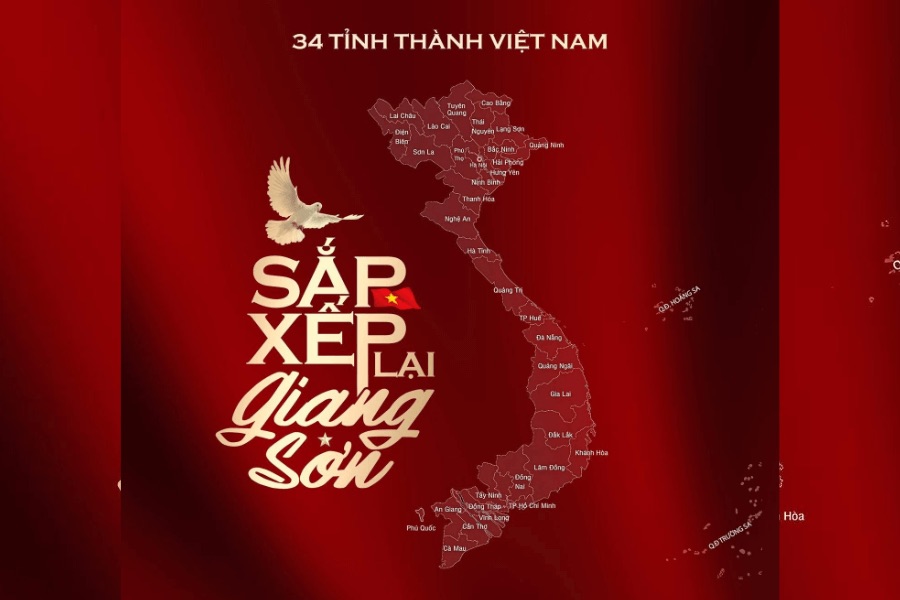Introduction to Vietnam’s Provincial Merger 2025
Vietnam is set to transform its administrative landscape with the Vietnam’s Provincial Merger 2025, effective July 1, 2025. This landmark reform, formalized under Resolution No.202/2025/QH15 by the 11th plenum of the 13th Party Central Committee, consolidates Vietnam’s 63 provinces and cities into 34, comprising 28 provinces and 6 centrally governed cities. The initiative, part of Vietnam’s Governance Reform and Provincial Mergers, introduces a two-tier governance system, eliminating district-level administrations to boost efficiency, economic growth, and public services.
For travelers exploring Vietnam and Indochina travel, this merger creates larger, more diverse regions, blending urban vibrancy, cultural heritage, and natural wonders. From the expanded Ho Chi Minh City to the scenic Lao Cai, this guide explores how the Vietnam’s Provincial Merger 2025 enhances travel across Vietnam and its neighbors, offering tips to navigate the new administrative map for unforgettable Vietnam tours 2025 and Indochina adventures.
Timeline of Vietnam’s Governance Reform
June 12, 2025: The National Assembly passed the amended Law on Local Government Organization, setting July 1, 2025, as the effective date for the Vietnam’s Provincial Merger 2025.
June 30, 2025: All 34 new and unchanged provincial units finalized leadership structures. The Vietnam Department of Survey, Mapping, and Geographic Information released updated digital maps reflecting new boundaries.
July 1, 2025: The Vietnam’s Provincial Merger 2025 and two-tier governance system took effect, dissolving district-level administrations and reducing commune-level units by 60–70%.
This timeline highlights Vietnam’s commitment to a smooth transition, ensuring stability for residents and visitors exploring the new regions.
Understanding the Two-Tier Governance System
The Vietnam’s Provincial Merger 2025 introduces a two-tier local government system, effective July 1, 2025, streamlining administration into provincial and commune levels. Key features include:
Provincial Level: Consists of 34 units (28 provinces and 6 centrally governed cities: Hanoi, Ho Chi Minh City, Hai Phong, Da Nang, Can Tho, and Thai Nguyen). Provinces manage major tasks like economic planning, infrastructure, and land-use rights.
Commune Level: Handles local services, such as issuing land-use certificates and supporting tourism initiatives. The reform reduces commune units by 60–70% for efficiency.
Elimination of Districts: Removing district-level administrations saves an estimated $7.3 billion by 2030, streamlining bureaucracy and improving service delivery.
Benefits for Vietnam and Indochina Travel
Streamlined Processes: Centralized provincial services simplify permits and registrations for international travelers.
Enhanced Connectivity: Larger provinces improve transport networks, connecting Vietnam’s urban hubs with rural and cross-border destinations in Laos and Cambodia.
Diverse Experiences: Merged regions offer a mix of urban, cultural, and natural attractions, ideal for multi-country Indochina travel itineraries.
This system enhances accessibility, making Vietnam and Indochina travel more seamless and enriching.
List of Merged Provinces and Cities in Vietnam’s Provincial Merger 2025
The Vietnam’s Provincial Merger 2025 consolidates 63 administrative units into 34. Below is a list of merged provinces and cities with their new administrative centers:
Merged Units | New Province/City | New Admin Center |
|---|---|---|
Tuyen Quang + Ha Giang | Tuyen Quang | Tuyen Quang City |
Lao Cai + Yen Bai | Lao Cai | Yen Bai City |
Bac Kan + Thai Nguyen | Thai Nguyen | Thai Nguyen City |
Vinh Phuc + Phu Tho + Hoa Binh | Phu Tho | Viet Tri City |
Bac Ninh + Bac Giang | Bac Ninh | Bac Giang City |
Hung Yen + Thai Binh | Hung Yen | Hung Yen City |
Hai Duong + Hai Phong | Hai Phong | Hai Phong City |
Ha Nam + Ninh Binh + Nam Dinh | Ninh Binh | Ninh Binh City |
Quang Binh + Quang Tri | Quang Tri | Dong Hoi City |
Quang Nam + Da Nang | Da Nang | Da Nang City |
Kon Tum + Quang Ngai | Quang Ngai | Quang Ngai City |
Gia Lai + Binh Dinh | Gia Lai | Quy Nhon City |
Ninh Thuan + Khanh Hoa | Khanh Hoa | Nha Trang City |
Lam Dong + Dak Nong + Binh Thuan | Lam Dong | Da Lat City |
Dak Lak + Phu Yen | Dak Lak | Buon Ma Thuot City |
Ba Ria-Vung Tau + Binh Duong + HCMC | Ho Chi Minh City | Ho Chi Minh City |
Dong Nai + Binh Phuoc | Dong Nai | Bien Hoa City |
Tay Ninh + Long An | Tay Ninh | Tan An City |
Can Tho + Soc Trang + Hau Giang | Can Tho | Can Tho City |
Ben Tre + Vinh Long + Tra Vinh | Vinh Long | Vinh Long City |
Tien Giang + Dong Thap | Dong Thap | My Tho City |
Bac Lieu + Ca Mau | Ca Mau | Ca Mau City |
An Giang + Kien Giang | An Giang | Rach Gia City |
Unchanged Provinces
Eleven provinces remain unaffected, offering familiar destinations for travelers:
Hanoi: Known for Hoan Kiem Lake and the Old Quarter.
Hue: Home to the UNESCO-listed Imperial City.
Lai Chau: Offers ethnic markets and rugged landscapes.
Dien Bien: Famous for the Dien Bien Phu Victory site.
Son La: Features Moc Chau’s tea plantations.
Cao Bang: Boasts Ban Gioc Waterfall.
Lang Son: Known for vibrant border markets.
Quang Ninh: Home to Ha Long Bay, a UNESCO site.
Thanh Hoa: Offers Sam Son Beach and Ho Citadel.
Nghe An: Birthplace of Ho Chi Minh.
Ha Tinh: Features historical sites like Ke Go Lake.
These provinces provide a stable base for exploring Vietnam’s updated tourism landscape.
Impact on Vietnam and Indochina Travel
The Vietnam’s Provincial Merger 2025 reshapes Vietnam tours 2025 and Indochina tours by creating integrated regions and improving infrastructure. Here’s how it impacts travelers:
Benefits for Travelers
Diverse Destinations: Merged provinces like Khanh Hoa (Nha Trang) combine beaches and cultural sites, ideal for multi-destination Indochina itineraries.
Improved Connectivity: Enhanced highways and transport links facilitate travel within Vietnam and to Laos and Cambodia.
Simplified Processes: Centralized services streamline visa and permit processes, benefiting cross-border Indochina travel.
Tourism Growth: The Vietnam Private Sector Forum 2025 promotes tourism-friendly policies, boosting services like hotels and tour operators.
Cultural Integration: Larger regions combine festivals and ethnic diversity, enriching experiences in provinces like An Giang.
Limitations
Transition Period (July–December 2025): Minor disruptions in rural areas may require flexible planning.
Navigation Updates: Travelers must use updated maps to navigate the new 34 provinces.
Practical Tips for Vietnam and Indochina Travel
To make the most of Vietnam’s Provincial Merger 2025, follow these tips:
Update Navigation Tools: Download digital maps from map.vietnam.vn to reflect the new 34 provinces.
Plan Flexible Itineraries: Allow extra time for rural travel during the transition. Book through reputable operators for multi-country Indochina travel.
Explore New Regions: Visit merged provinces like Lao Cai for trekking or Da Nang for coastal and cultural experiences, and extend to Laos or Cambodia.
Embrace Cultural Diversity: Engage with local festivals, such as An Giang’s Ba Chua Xu, to enrich your journey.
FAQs About Vietnam’s Provincial Merger 2025
What is Vietnam’s Provincial Merger 2025?
The merger reduces Vietnam’s 63 provinces to 34, effective July 1, 2025, adopting a two-tier system for efficiency.How does it affect Vietnam and Indochina travel?
It creates diverse regions, improves connectivity, and simplifies processes, enhancing multi-country itineraries.Which provinces remain unchanged?
Hue, Quang Ninh, Lai Chau, Cao Bang, Nghe An, and six others remain unaffected.How does the merger enhance tourism?
Larger provinces offer diverse attractions, improved infrastructure, and streamlined services for Vietnam tours 2025.Are there new travel requirements?
No new requirements, but update navigation tools and check provincial offices for permits.How can I navigate the new map?
Use updated digital maps from map.vietnam.vn or ensure GPS apps reflect the new 34 provinces.Will festivals be affected?
Merged provinces may combine festivals, creating richer cultural experiences for travelers.
Plan your Vietnam tours 2025 and Indochina tour adventures to explore the reimagined regions of the Vietnam’s Provincial Merger 2025!






